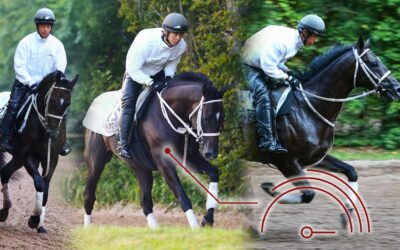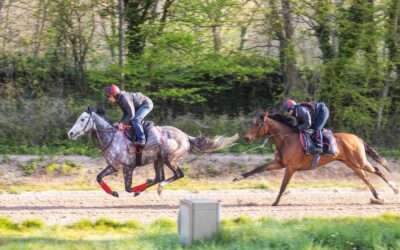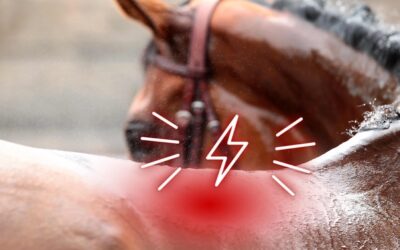The racehorse’s performance is essential to the equine industry. Every trainer and racehorse wants to be the best in the few minutes after the starting gates open. Aside from having the necessary fitness, pedigree, stall number, or good track condition, the horse must also hope to have the ideal course: the perfect race. The show as we know it now comes from the uncertainty that arises from the alignment of these many components.
What if we told you that data may help anticipate a horse’s performance, or at the very least give a horse’s trainer and owner more confidence on the racetrack?
Our team analyzed the data of 3 fillies during their last trainings before the race, in order to evaluate if their data could have predicted a good result, or on the contrary help avoid a counter-performance.
Training data analysis context
The data acquired during three Equimetre-monitored training sessions on the Chantilly racecourse is the topic of this case study. For privacy reasons, we have anonymised these three fillies.
Arionea is a 3-year-old filly and did not race in her two-year-old season. She made her debut in May over 2000m without success. She then ran a longer distance of 2500m and won her second race, showing good abilities. We will analyze her last pre-race training, which took place five days before her Saturday race.
Arionela is also a 3-years-old mare and she started to race during her 2-years-old season, with 1 victory. She did not raced during her 3-years-old season yet but she will make her comeback in the beginning of July, after the training we are going to analyze.
Mrs. Arionea is a 4 years old female, whose record in Group race opened during her 3 years old year. After the training we will study here, she has to run a Group 1 race.
The parameters of the analysis
-
The maximum heart rate (HRmax) – The maximum heart rate is the maximum number of beats per minute (BPM) your horse’s heart can achieve during intense exercise. Once reached, the heart rate stabilizes and will not increase. It is specific to each horse and is physiological. It is not correlated with performance and decreases slightly with age.
- Fast recovery – This parameter is in BPM and shows the intensity of the effort felt by the horse. It is the first stabilization of the heart rate right after the effort.
- Heart rate at 15 mins – This parameter is expressed in BPM and shows the fitness level of the horse. A horse with a good fitness level has a fast heart rate elasticity.
- The oxygen debt – It is defined as the excess oxygen consumed during the recovery phase after exercise. It is the time in seconds between the end of the training, automatically detected when the speed begins to decrease, and the time of fast recovery.
- Fast recovery as a percentage of max heart rate (HRmax) – The percentage of maximum heart rate at the end of the fast recovery following the last high intensity exercise. This value is used to compare horses to each other, taking into account their difference in HRmax. Generally, we look for a fast recovery of less than 55% of the HRmax.
- Recovery after 15 mins as a percentage of max heart rate – Percentage of maximum heart rate after 15 minutes of recovery from the last high intensity exercise. Typically, we look for a quick recovery of less than 50% of HRmax.
Data analysis
To get a first overview of the three fillies’ fitness levels, we first use the comparison feature of the Equimetre platform.
Training parameters:
-
-
- The mares did not go at the same speed. Arionela reached a maximum speed of 57.3 km/h, unlike Mrs. Arionea and Arionea who reached 60 km/h.
-
- Mrs. Arionea had a slightly longer training of 2600m, unlike Arionela and Arionea with a distance of about 2300m.
-
However, trainings are similar enough to allow for an initial comparison analysis.

Data from the EQUIMETRE platform
First analysis – The fast recovery and the intensity of the effort
First, we can analyze the fast recovery of these three fillies.
- Arionea shows the best recovery, with a BPM of 120 immediately after the effort, and after having gone up to 222 BPM. Arionea seems to have more ease with this exercise.
- Mrs. Arionea shows a nice heart rate elasticity, with a BPM of 126 immediately after her effort, and after having gone up to 236 BPM during her gallop. She seems to assimilate the effort easily.
- Finally, Arionela shows a poor fast recovery, with a post-effort heart rate of 141 BPM. We can deduce from this that the effort required was difficult for the filly. It may be wise to analyze Arionela’s average data in order to identify a possible issue.

Data from the EQUIMETRE platform
Second analysis – Recovery 15 mins after exercise and fitness level.
- Mrs. Arionea, older than our two other fillies, shows an excellent recovery 15 mins after exercise. Indeed, the mare is below the 100 BPM mark 15 mins after her gallop. This shows a good level of fitness.
- Arionea also shows a good level of fitness, with a heart rate of 103 BPM 15 minutes after exercise. Remember that for this value, we generally want a heart rate above 100 BPM.
- Finally, Arionela, for whom the effort was very intense, shows a heart rate of 124 BPM. This is quite a high value, and we could deduce that the mare needs to progress before having the necessary fitness to race.
Deepen the training data analysis
Although this data helps us to have a first idea of the mares’ fitness level and ability to run, it is interesting to complete the analysis with some more technical parameters. To do this, let’s go to the Analytics table of the analysis platform.
➡️ To learn more about the Analytics tab, you should read this article.
To compare the recoveries while taking into account the physiological differences of the mares, we will look at the recovery parameters as a percentage of the horses’ HRMax.

Data from the EQUIMETRE platform
- We notice that for the fast recovery, Arionea and Mrs. Arionea stand out, with percentages lower than the reference of 55% for this parameter.
- On the other hand, Arionela has a percentage of almost 65%. This confirms our first analysis: the training was difficult for the mare.
Then, it is interesting to look at the time spent in zone 5, as well as the time to get back down to 120 and 100 BPM, which shows the efficiency of the horses’ metabolism.

Data from the EQUIMETRE platform
Arionela and Mrs. Arionea spent the same amount of time in zone 5, give or take 2 seconds. However, Mrs. Arionea, having done a more intense work, incurred a higher oxygen debt to sustain her effort. This explains why her heart rate remains higher after exercise – her body requires the heart to pump frequently to provide the necessary oxygen. However, using the time to get down to 100 BPM parameter, we see that Mrs. Arionea stands out, as the mare recovers better than Arionela. This can be explained by the age and maturity of the mare, as well as by a better level of fitness at that moment.
Arionea’s data are excellent, and show the mare’s fitness. She is ready for her race this weekend and has the ability to perform well.
Interpretation – What to expect from these horses for their next race?
- Arionea is ready to race, and has an excellent level of fitness.
- Ms. Arionea is also ready, and has an excellent fitness level.
- Arionela has not yet reached her optimal fitness level to be able to perform.
Data and performance – What were the results of these 3 horses?
- Arionea won her race.
- Mrs. Arionea finished 4th in her group, following a course that failed her.
- Arionela did not perform well and finished 8th, not having been able to make the effort in the straight line.
Conclusion
It is obvious that data will never replace the feeling and expertise of trainers. However, they are an important support when entering a horse or making important decisions. Indeed, in case of uncertainty, it can be interesting to refer to figures in order to confirm one’s instinct. In this case, the example of Arionela proves that the data could have allowed the trainer to avoid racing the filly, in order to allow her to gain in fitness. On the contrary, and to end on a positive note, Arionea’s and Mrs. Arionea’s data demonstrated that the mares had every chance to perform well. This data is also a great help in developing the most appropriate race strategy.
Keywords: data and performance, recovery, heart rate, comparison, racehorses, Equimetre
These articles may also be of interest to you
Exercises of varying intensity: what effect on the horse?
During exercise of varying intensities, the different systems of the horse’s body adapt their functioning. In this article we will look at these changes through the respiratory, cardiovascular and muscular systems.
What influence do age and training have on Thoroughbreds?
Data has been increasingly important in the world of sports in recent years. It affects every discipline, including horse racing. As a result, a group of researchers asked the following question: what are the impacts of age and training on Thoroughbreds?
Kissing spines: how to detect them with data?
Kissing spines are a common cause of back pain in horses. How can data help to detect and understand this bone disease?
BROWSE AMONG OTHER CATEGORIES
Equine physiology
Science & health
Data & Sports
Racehorse training
Stride analysis
Standarbreds
Equimetre
Speed
Young racehorses

SUBSCRIBE TO OUR NEWSLETTER
Let’s stay in touch: to get our latest articles and follow EQUIMETRE news, fill-in this form.






